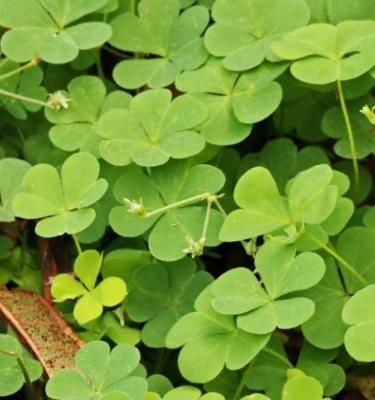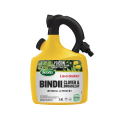

How to Get Rid of Oxalis Weed & Wood Sorrel
There are over 500 species of Oxalis weed, many grown ornamentally, but a number of which can become a very difficult garden weed. Commonly known as wood sorrel, Oxalis weed is found worldwide and can be an annual or perennial.
Most problematic Oxalis weeds have a fleshy tuber beneath the soil, allowing them to store energy and making them quite resistant to efforts to kill them. Others produce multiple tiny bulbils which ‘explode’ when disturbed, each producing a new plant. It is also easy to bring them into the garden in the pots of other plants.
The following species of Oxalis weed are problematic across gardens in Australia:
- Oxalis articulata (Pink sorrel, pink wood sorrel, sour grass)
- Oxalis bowiei (Bowie’s wood-sorrel, red-flower sorrel, cape shamrock)
- Oxalis corniculata (Creeping oxalis, creeping wood sorrel, procumbent yellow sorrel, sleeping beauty)
- Oxalis corymbosa (Pink oxalis)
- Oxalis exilis (Least yellow sorrel)
- Oxalis incarnata (Pale wood-sorrel, crimson wood sorrel, climbing Oxalis)
- Oxalis latifolia (Fishtail wood-sorrel, broadleaf wood sorrel, pink shamrock)
- Oxalis pes-caprae (African wood sorrel, Bermuda buttercup, Bermuda sorrel, buttercup oxalis, Cape sorrel, Cape cowslip, English weed, goat’s foot, Oxalis cernua, sourgrass, Soursob)
- Oxalis purpurea (Large-flower woodsorrel)
Oxalis plants are often found in gaps between the sides of raised beds, between paving stones, and other hard-to-reach cracks!
How to identify Oxalis weed, a.k.a. wood sorrel
Oxalis spp. is sometimes confused with clover, but can be distinguished by having heart-shaped leaves and five flower petals. Its flowers are delicate and attractive, and are white, pink, violet, red or yellow:
- Oxalis articulata. Pink or violet flowers with petals 1-1.5cm in length. Grows to 45cm tall and prefers moist conditions.
- Oxalis bowiei. Bright pink flowers, the stem is typically 30cm or more in height.
- Oxalis corniculata. Small yellow flowers, with green or reddish-purple leaves which closely resemble clover. This low growing, creeping weed can easily be missed around the base of other plants. Very common and a rapacious spreader.
- Oxalis corymbosa. Pink flowers and dark green leaves.
- Oxalis exilis. A tiny species with intricate yellow flowers. Native to Australia.
- Oxalis incarnata. Individual stems up to 30cm each, but can spread higher against a wall or fence. Does particularly well in moist, shaded sites. White or light pink petals.
- Oxalis latifolia. Very low growing, with no stem. Fishtail or heart-shaped leaflets with pink, occasionally white, flowers.
- Oxalis pes-caprae. Bright yellow flowers on this densely growing upright plant, which can reach up to 40cm in height. Particularly invasive, each plant can typically produce 20 new plants from its bulbils.
- Oxalis purpurea. Dark green leaves, single deep pink flowers, occasionally white, with petals that are 2cm or more in length.
Most Oxalis species are not native to Australia, which thankfully means the seeds of them are rarely viable. However, they often have a milky coloured or brown bulb with many bulbils attached, which can help them to spread and are hard to reach when under a lawn.
Recognising the symptoms of Oxalis weed
Oxalis spp. can furtively colonise an area of lawn, quietly creeping beneath the runners of grass to establish itself. It is then difficult to eradicate without damaging the grass at the same time. The first sign of it may be the innocent looking, beautiful flowers, popping up in the lawn. On closer inspection of the soil surface, it becomes apparent that grass has been peppered by this invasive weed.
Most troublesome species of Oxalis have tuberous and fleshy roots, which will sit below the grass surface and spread through the soil, making it even harder to bring under control.
How to get rid of Oxalis weed
Tackle Oxalis before they flower and go to seed, by raking and mowing, and then collecting and removing segments of plant from the garden. This may play a small part in disrupting the seed-setting lifecycle of Oxalis, however it will not control vegetative growth of the plant. It may still slow down the ability of the plants to gather energy through its foliage, naturally weakening it over a long period of time.
Another organic and non-chemical approach to controlling Oxalis weed is to diligently remove whole plants by hand, being sure to remove all traces of the plant. You may need to remove surrounding soil using a trowel so that no bulbils are left behind to regrow. Never add Oxalis to the compost heap.
If there is a large area of Oxalis, and the methods above cannot be used, other action should be taken. We recommend Scotts Lawn Builder™ Bindii Weedkiller for use on most types of Oxalis, and it is particularly effective in getting rid of Oxalis corniculata (creeping Oxalis). This Oxalis weed killer can be used all year round and on most types of grass, although always check the label to ensure it is suitable for your lawn. We think this is the best Oxalis killer available to control this difficult weed.
An alternative is a Glyphosate-based weed killer product. However these can kill other nearby plants if not handled carefully, so is not recommended to use in lawns or near to other plants.
Expect to apply chemical treatments several times. Follow the manufacturer’s guidance so that weedkiller is applied at a rate which is safe for the lawn and other plants and animals. Between applications of weedkiller, and in close parallel with the manufacturer’s instructions, applying a feed can give grass a boost and help it to get ahead of the Oxalis.
In the cracks of hard surfaces, burning the tops off with a garden flame gun will weaken the plant. Hoe flower beds, dispose of all sections of Oxalis plant, and cover with a thick mulch such as Debco® Natural Designer Mulch or garden compost, to smother growth.
A last resort is to remove the affected turf entirely, along with all sections of weed, and lay a new lawn.
How to prevent Oxalis weed
As with most opportunistic weeds, prevention is better than the cure. Keep the lawn in good health by feeding the lawn with a suitable fertiliser, such as Scotts Lawn Builder™ +Weedkill Slow Release Lawn Fertiliser, applied using Scotts® Easy Handheld Fertiliser Spreader. Always check that a product is suitable for the type of lawn growing in your backyard, as some are not suitable for varieties of grass.
Avoid disturbing the soil, which can spread bulbils and other sections of plant, and check newly purchased plants for weedy growth on the surface of the soil.












